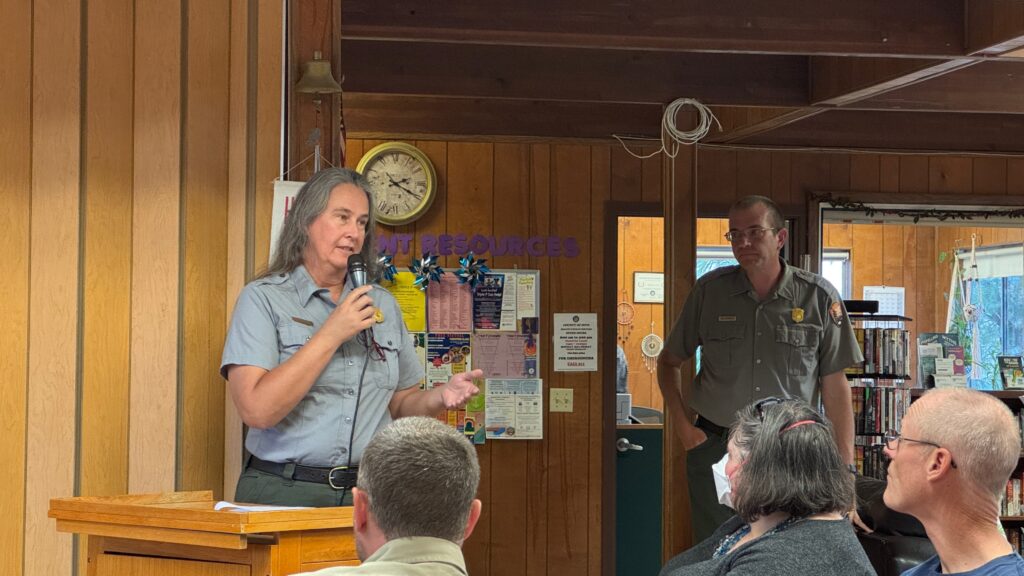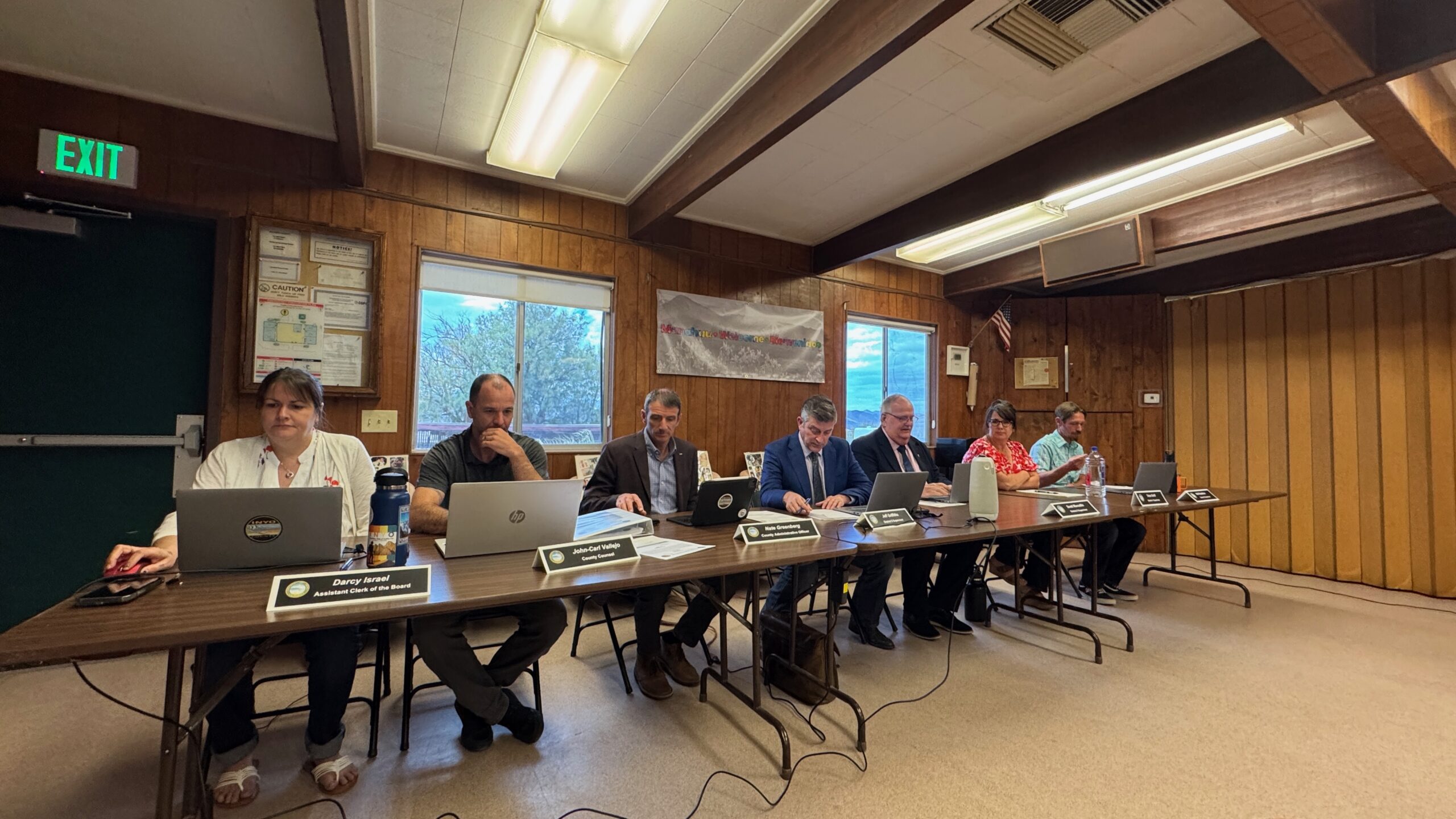In the sun-scorched expanse of eastern California, Inyo County and Death Valley National Park are tightening their coordination in the face of extreme weather, federal staffing cuts, and aging infrastructure. Together, they are managing a uniquely challenging intersection of rural resilience and world-renowned tourism.
Death Valley National Park’s Superintendent Mike Reynolds and Management Analyst Abby Wines updated residents on conditions at the park during the Inyo County Board of Supervisors’ annual spring pilgrimage to Southeast Inyo. The special meeting, held May 6 at the Tecopa Community Center, offered a rare in-person opportunity for residents to hear directly from park and county leadership about ongoing projects, budget realities, and the unique challenges of managing public lands in one of the most remote corners of California.
Spanning 3.4 million acres—an expanse larger than Connecticut—Death Valley National Park covers 52% of Inyo County’s landmass, with 94% of the park located entirely within county lines. While the Park Service is a federal agency, the reality on the ground is deeply local. Emergency services like law enforcement, fire response, and EMS are often backed up by Inyo County personnel, whose roles grow more critical as federal staffing and resources shrink.
This month, Inyo County Sheriff Stephanie Rennie and park officials signed a new mutual aid agreement, formalizing shared responsibilities for public safety. As park staffing continues to decline due to budget uncertainty and hiring freezes, the ability to deploy county resources in times of crisis—particularly in medical emergencies, search and rescue, and natural disasters—has become vital.
Burros and Boardwalks
The park has faced a cascade of challenges in recent years. Following record flooding from Hurricane Hilary in 2023 and previous storm events in 2022, a $15 million federal repair project is underway to reconstruct paved roads across the park. Initial patchwork repairs failed due to roadbed sagging, prompting more extensive efforts this winter to rebuild and reinforce road shoulders to withstand future washouts.
Off-road routes remain a work in progress, with Titus Canyon Road—one of the park’s most iconic backcountry drives—expected to enter reconstruction later this year.
One peculiar concern this past year involved a mysterious die-off of feral burros near Aloe Spring, initially feared to be a disease outbreak, which technically occurred in San Bernardino County. Biologists now suspect the cause was a toxic algae bloom, worsened by rising temperatures and high nitrogen levels from burro waste. A fence was installed to keep burros out of the spring while still allowing access to native species like bighorn sheep and coyotes.
Yet not all news is grim. Recent upgrades include a successful restoration of flood damage to the decommissioned landfill cap at Furnace Creek and new culverts under Highway 190. Installed by Caltrans, these culverts are restoring the natural flow of Furnace Creek, improving safety and habitat for rare endemic species including two snails, four crustaceans, and two insects found nowhere else on Earth.
The Salt Creek boardwalk is nearly complete and expected to reopen to the public within one to two months. Park biologists report that hundreds of endangered pupfish are thriving in the area.
Southern California Edison is also close to finishing a project that installs solar panels on park housing and facilities, and retrofitting office lighting with energy-efficient LEDs.
Meanwhile, the Stovepipe Wells Resort concessionaire continues facility upgrades.
Looking ahead, the park is pursuing $62 million to replace major components of the Cow Creek and Furnace Creek wastewater systems. “On average, we have a break at one of the water systems in the park every week,” said Abby Wines, Management Analyst at Death Valley National Park. “It’s just killing us in the overtime and hopefully doesn’t literally kill any employees when it happens in the middle of the summer.”
Budget Constraints and Workforce Impacts

The severity of the park’s funding challenges became especially apparent earlier this year when its federal purchasing cards were temporarily shut off. Basic supplies to critical operations required a cumbersome workaround, and now only six staff are authorized to make purchases and each transaction requires individual approval.
“Ironically, one of the things we couldn’t pay was our Starlink bill,” Wines noted.
Looking ahead to Fiscal Year 2026, the operational strain is already being felt. Park officials report that one-third of anticipated projects have been canceled in advance, not due to lack of vision or need, but because the capacity simply does not exist to execute them. One major bottleneck stems from new Department of the Interior mandatory contract review requirements, which have added several months to the approval process.
Hiring remains a challenge. The park typically employs 20–25 temporary staff alongside 30 volunteers during the winter, but permanent staffing has been impacted by buyouts, resignations, and a hiring freeze currently in place until July 15. Five staff were terminated and later rehired due to a court order. Four others accepted buyouts, one resigned without buyout, and one employee died. With only one permanent position converted and 31 others left unfilled, the park faces a net loss of five employees—about 6% of its workforce.
A federal executive order now mandates that agencies may only hire one new employee for every four that depart, excluding military and law enforcement. In addition, even as seasonal roles remain authorized, there are not enough HR staff to process them, as they are mostly working to reduce the federal workforce, complicating future planning for events like the Dark Sky Festival or winter campground openings.
In the short term, some services have been scaled back. The water system at Wildrose Campground has been closed, eliminating 2.5 hours of labor per day, and restroom cleaning frequency has been reduced. Outreach efforts, including public events, have also been cut back.
Scotty’s Castle: A Tale of Delays
Restoration of the historic Scotty’s Castle complex remains mired in bureaucratic and environmental setbacks. Damaged by floods in 2015 and again in 2017, progress has been slowed by historic preservation reviews, fires, pandemic closures, and other competing crises.
“I’d love to be able to tell you when Scotty’s Castle is going to be open, but I’ve given up trying to forecast—not that we’ve given up doing it—just giving up trying to forecast what the date is that will happen,” said Wines.
The remaining work includes completing eight miles of roadwork and replacing septic, electrical, and water systems, as well as work on out buildings and walkways. When asked if it would flood again, Wines replied wryly, “Of course it’s going to flood again—we’re in the desert, and that’s what happens.”
To protect the site, a new berm, flood walls, and drainage channels have been installed up canyon.
The Strange and Surreal
In the spirit of Death Valley’s legendary weirdness, Wines offered a few anecdotes from recent months. A truck hauling chickpeas crashed and caught fire, and after park rangers watered the scene, chickpea plants sprouted along the roadside. The park also received three false 911 calls about people being on fire, and ostriches were captured by park employees after escaping from a farm in Amargosa Valley.
Looking Ahead
Death Valley National Park continues to draw visitors from around the world—1.4 million last year alone—contributing over $103 million to gateway communities, mostly in Inyo County. While summer attracts many visitors, winter visitation remains especially strong, with guests staying longer and spending more, helping to fund vital county services.
Last year, Inyo County collected $70,000 in transient occupancy tax (TOT) from Death Valley tourism that will now be used to convert a former elementary school into a new community center.
As uncertainty over budgets and staffing persists, park officials remain focused on the long road ahead. Death Valley National Park still has not received its specific allocation for Fiscal Year 2025, which ends September 30. Without a finalized budget, park officials remain in a holding pattern—unable to fully commit to planned projects, authorize new contracts, or confidently plan for seasonal operations. This financial uncertainty, layered on top of ongoing staffing and procurement constraints, is hampering the park’s ability to maintain momentum on critical repairs and visitor services.
“Thank you for everyone working so hard and being so flexible to keep the park running and keep the visitor experience as good as it possibly can during these times, I don’t know how you are going to pull it off in the future. If there are ways the county can partner with that, please let us know and please keep us informed,” said Inyo County Supervisor Jeff Griffiths.
He reminded the public that the federal budget has not yet been passed and residents can advocate for the park: “There is still time to call Kevin Kiley, your Congressmember.”


Leave a Reply